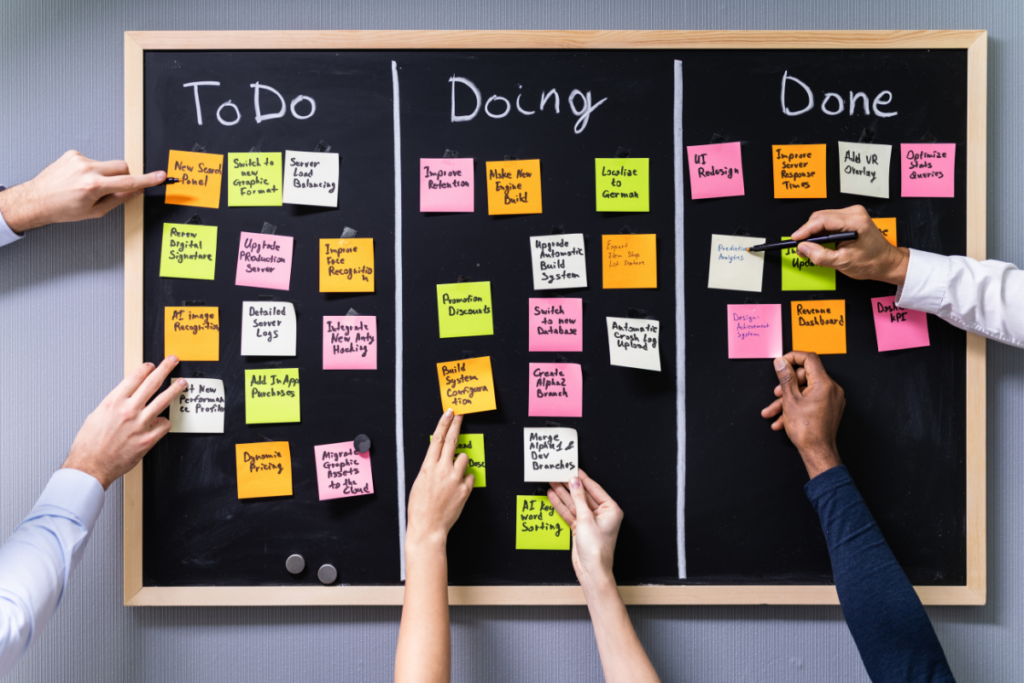Choosing the right project planning methodology is like selecting the right tool for the job—you wouldn’t use a hammer when you need a screwdriver! The right approach can determine your project’s success. So, what factors should you consider?
Understanding your business needs
Before diving into project planning methodology, you need to understand your business needs. What works for a software development team might not work for a construction project.
Your business needs are the foundation of your decision. Are you dealing with complex projects that require flexibility? Or do you have well-defined tasks that follow a linear path? Knowing your business needs will help you narrow down the best project management techniques.
The Agile methodology: flexibility at its best
Agile methodology is like the Swiss Army knife of project planning. It is flexible, adaptable, and perfect for projects where requirements might change. Agile focuses on delivering small, incremental improvements rather than one large-scale final product. This makes it ideal for software development teams or any business that values continuous improvement.
In an agile framework, teams work in short cycles called sprints. At the end of each sprint, they review progress and adjust plans as needed. This iterative approach ensures that the final product meets the client’s needs, even if those needs evolve. If your business needs include frequent feedback and flexibility, agile methodology is worth considering.
For example, if your team thrives on collaboration and quick adjustments, an agile methodology might be your best bet. If your projects are predictable and need strict timelines, the waterfall approach might work better. The key is to align your methodology with your business needs.

The Scrum framework: teamwork makes the dream work
Scrum is a subset of agile methodology, but it is so popular that it deserves its own spotlight. The scrum framework emphasizes teamwork, accountability, and iterative progress. It is like Agile’s more structured cousin. Scrum teams work in fixed-length sprints, usually two to four weeks long, and have specific roles like Scrum Master and Product Owner.
The Scrum Master ensures the team stays on track, while the Product Owner organizes tasks based on business needs. This framework is great for complex projects that require frequent feedback and adaptation. If your business thrives on collaboration and clear roles, the scrum framework might be your go-to.
Waterfall: The old reliable methodology
If Agile approaches are the Swiss Army knife of project management, the waterfall methodology is the trusty hammer. It is a structured, step-by-step approach where each phase of the project is completed before progressing to the next. This method follows a logical order, similar to building construction, where foundational work must be finished before advancing to later stages, like painting the walls.
At a high level, waterfall is ideal for tasks with clearly defined project scopes and minimal expected changes. It is simple and easy to handle, making it a favored option in industries such as construction and manufacturing.
However, waterfall is less flexible compared to agile or scrum. It may not work well for projects where requirements evolve frequently, unlike agile team environments that thrive on flexibility. For example, agile teams use sprint retrospectives to improve processes. The Waterfall project planning methodology doesn’t include this kind of iterative feedback.
Similarly, cross-functional teams often excel in agile approaches like extreme programming (XP), where collaboration and flexibility are key. If your project requires frequent changes, a more flexible project management tool or method may work better than waterfall.
Kanban board: visualize your workflow
Kanban is all about display. It tracks tasks and progress using boards and cards, making it easy to see current work and upcoming tasks. This method focuses on continuous delivery, making it ideal for teams with ongoing or variable workloads.
If your business needs include managing multiple tasks simultaneously, Kanban can help you stay organized. It is like having a giant to-do list that everyone can see. Moreover, it’s easy to implement and doesn’t require a major shift in how your team operates.

Critical Path Method (CPM): for the detail-oriented
The Critical Path Method (CPM) is perfect for projects with well-defined tasks and dependencies. It identifies the longest sequence of dependent tasks (the critical path) to determine the minimum project duration. This method is great for businesses that need to manage complex projects with tight deadlines.
CPM requires careful planning, much like piecing together a complex puzzle. You need to figure out which tasks are most important and how they fit together. If your business needs include detailed resource planning and timeline management, CPM could be the right choice.
PRINCE2 methodology: process-driven and structured
PRINCE2 (Projects IN Controlled Environments) is a process-driven methodology that divides projects into stages with defined roles, responsibilities, and documentation. It is commonly used in government and large organizations where structure and accountability are crucial.
If your business needs include strict governance and clear documentation, PRINCE2 might be the way to go. It is like having a rulebook for your project, ensuring everyone knows their role and what’s expected.
Lean and Six Sigma: maximizing efficiency
Lean project planning methodology focuses on maximizing value by getting rid of waste and optimizing processes. It is often used in manufacturing and software development. Six Sigma is a data-driven method that improves quality by finding and fixing defects.
When combined (Lean Six Sigma), these methodologies can help businesses streamline operations and improve quality. If your business needs include process improvement and efficiency, Lean and Six Sigma are worth exploring.
Hybrid: the best of both worlds
Sometimes, one project planning methodology is not enough. That is where hybrid approaches come in. A hybrid methodology combines elements of different methodologies to tailor the approach to your business needs. For example, you might use Waterfall methodology for the initial planning stages and agile for execution.
Hybrid methodologies are like customizing your own toolkit. You pick the tools that work best for your project, ensuring maximum efficiency and flexibility. If your business needs include both structure and flexibility, a hybrid approach could be the perfect solution.
Key components of project planning methodologies
No matter which project planning methodology you choose, there are some key components to keep in mind:
- Scope definition: clearly define your project goals, tasks, and boundaries.
- Task breakdown: divide the project into manageable tasks.
- Resource allocation: assign team members, budget, and tools to tasks.
- Timeline development: create schedules and milestones.
- Risk management: identify and mitigate potential risks.
- Monitoring and control: track progress and adjust as needed.
These components are the building blocks of any successful project. They ensure that your project stays on track and meets its goals.
How can Furious help?
Choosing the right project planning methodology is just the first step. Implementing it effectively is where the real challenge lies. This is where Furious offers effective solutions.
Furious is an ERP designed for agencies and consulting firms. It centralizes everything—CRM, staffing, financial management, and reporting—into one tool.
With Furious, you can streamline your project management processes, no matter which methodology you choose. Whether you’re using agile, scrum, waterfall, or a hybrid approach, Furious provides the tools you need to succeed. It is like having a project management Swiss Army knife at your fingertips.
Choose wisely, execute smartly
Choosing the best project planning methodology for your business isn’t just about picking a framework. It is about understanding your business needs, your team’s strengths, and your project’s requirements. Whether you go with agile, scrum, waterfall, or a hybrid approach, the key is to stay flexible and adapt as needed.
Keep in mind that you don’t have to handle this development process alone. A project management tool like Furious can help you easily implement your chosen methodology. It also allows you to keep your projects on track and efficiently.
So, take the time to evaluate your options, choose wisely, and execute smartly. Your business—and your team—will thank you.
By aligning your project planning methodology with your business needs, you can set your projects up for success. By choosing Furious as a partner, you gain access to the various tools and resources. They allow you to manage your projects with efficiency and professionalism.
Are you prepared to begin? Visit Furious today and see how we can help you streamline your project management processes.